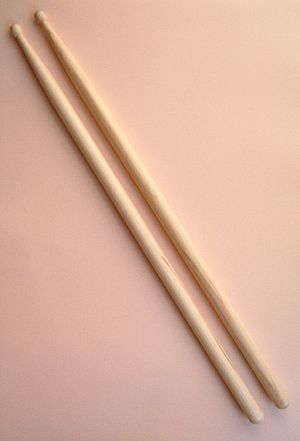Drum stick facts for kids

A drum stick or drumstick is a tool used by drummers to hit percussion instruments and make sounds. Just like a painter uses different brushes, a drummer uses different sticks! There are many kinds of drumsticks, and each one is designed for a specific sound or type of drum. For example, a stick used for a drum kit might look very different from one used for a snare drum. The weight, length, and the shape of the tip all change how a drumstick sounds. Some drums, like bongo drums, are played only with hands and don't need drumsticks at all.
Contents
What Are Drumsticks Made Of?
Drumsticks are usually made from different kinds of wood. The most common types of wood used are hickory, maple, and oak. Each wood has its own feel and sound.
Hickory Drumsticks
Hickory is the most popular wood for drumsticks. It is strong and can absorb shock well. This means it feels good in your hands and lasts a long time. Many drummers, from beginners to pros, choose hickory sticks.
Maple Drumsticks
Maple wood is lighter than hickory. This makes maple sticks faster to play, but they might not be as durable. Drummers who want a lighter touch or play very fast music often prefer maple sticks.
Oak Drumsticks
Oak is a very dense and heavy wood. Oak drumsticks are super durable and can create a powerful sound. They are great for drummers who hit hard or need a lot of volume.
Other Materials
Besides wood, drumsticks can also be made from other materials. Some are made from plastic, carbon fiber, or even aluminum. These materials can make sticks last longer or give them a different feel and sound.
Parts of a Drumstick
A drumstick might look simple, but it has different parts that help create different sounds. Knowing these parts can help you understand how drummers get their unique sounds.
The Butt End
This is the thickest part of the stick, usually where you hold it. Sometimes drummers flip the stick around and use the butt end to get a heavier, louder sound, especially on cymbals.
The Shaft
The shaft is the main body of the drumstick. It tapers, or gets thinner, as it goes towards the tip. The thickness and length of the shaft affect the stick's balance and how it feels to play.
The Shoulder
The shoulder is the part where the shaft starts to get thinner and curve towards the tip. This section is often used to hit cymbals for a crashing sound.
The Tip
The tip is the very end of the drumstick that hits the drum or cymbal. The shape and material of the tip are very important for the sound produced.
Types of Tips
Drumstick tips come in many shapes and materials.
- Wood Tips: These are the most common. They give a warm, natural sound on drums and cymbals.
- Nylon Tips: These tips are made of plastic. They create a brighter, clearer sound on cymbals and are very durable. They don't chip like wood tips can.
- Barrel Tips: These tips are rounded and wide, giving a full, powerful sound.
- Acorn Tips: Shaped like an acorn, these tips offer a focused sound with good rebound.
- Teardrop Tips: These tips are rounded and pointed, providing a clear sound with good articulation.
Different Sizes and Weights
Drumsticks come in many sizes, usually labeled with a number and a letter, like 5A, 7A, or 2B. These labels tell you about the stick's diameter and weight.
Common Sizes
- 7A: These are thinner and lighter sticks. They are great for jazz, acoustic music, or for younger drummers who need a lighter stick. They produce a softer sound.
- 5A: This is the most popular and versatile size. It's a good all-around stick for many styles of music, from rock to pop. It offers a good balance of weight and speed.
- 5B: These sticks are a bit thicker and heavier than 5A. They are good for rock, pop, and louder music where you need more power and volume.
- 2B: These are the thickest and heaviest of the common sizes. They are often used for marching band drumming, heavy rock, or when a drummer needs maximum power and durability.
The size and weight of a drumstick greatly affect how it feels to play and the sound it makes. Lighter sticks are faster but produce less volume, while heavier sticks are slower but can create a much louder sound.
Other Types of Beaters
While drumsticks are common, drummers also use other types of beaters to create different sounds.
Brushes
Drum brushes are made of many thin wires or plastic bristles. They are used to create soft, swishy sounds, especially in jazz music. Drummers can sweep them across the drumhead for a unique texture.
Rods
Rods, sometimes called "rutes," are made of many thin wooden dowels bundled together. They offer a sound that is softer than a drumstick but louder than a brush. They are great for playing in smaller venues or when you need a quieter drum sound.
Mallets
Mallets have soft, padded heads, often made of felt, rubber, or yarn. They are used on drums like bass drums, timpani, or marimbas to create a soft, warm, and sustained sound.
Images for kids
-
A selection of Nick Mason's customised drumsticks, from various makers, displayed at the Pink Floyd: Their Mortal Remains exhibition




